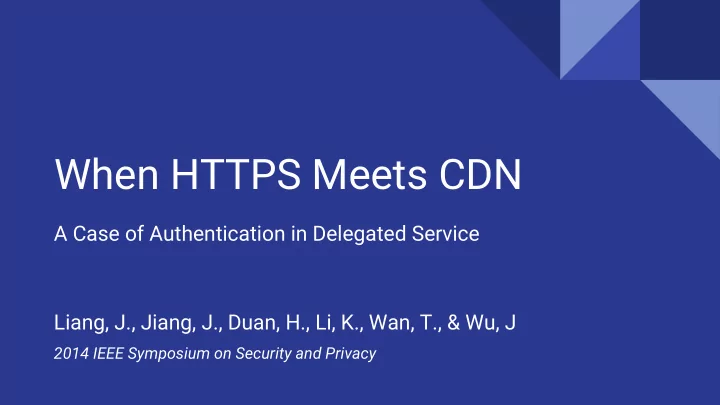

When HTTPS Meets CDN A Case of Authentication in Delegated Service Liang, J., Jiang, J., Duan, H., Li, K., Wan, T., & Wu, J 2014 IEEE Symposium on Security and Privacy
Web Traffic Needs Security! Goals = CIA triad Confidentiality Integrity Availability
Web Traffic Needs Security! Goals = CIA triad HTTPS end-to-end Confidentiality Integrity Availability
Web Traffic Needs Security! Goals = CIA triad Confidentiality CDN Integrity CDN Availability CDN Fast → Distribution Reliable → Firewalls, DDoS Protection
When CDNs meet HTTPS HTTPS provides end-to-end security CDN services 1) Fast Availability → Distribution: End-to-many-ends 2) Reliable Availability → Protection: End-to-CDN-to-end
CDN Mechanisms - URL Rewriting Main HTML on bank.com, bulk static content on cdn.com Doesn’t violate HTTPS end-to-end Doesn’t provide protection services GET: bank.com/ Update resources GET: CDN cdn.com/resources
CDN Mechanisms - DNS routing bank.com resolves to IP address of CDN server 1) CNAME record that maps bank.com → bank.cdn.com 2) CDN is the authoritative Name Server (NS) for bank.com Fetch/update GET: bank.com/ content CDN
Making HTTPS Work w/ DNS routing Certificate = public key + common name (CN) + signature chain Custom certificate Give CDN bank.com’s certificate + private key Increased attack surface Expensive CA revocation
Making HTTPS Work w/ DNS routing Shared certificate cdn.com cert vouches for bank.com Subject Alternate Name (SAN) extension Loses bank.com cert features - i.e. EV Expensive CA revocation
CDN Mechanisms in Practice Most CDNs use CNAME DNS routing 68% of certs are invalid! Custom and shared certs are popular
Case study: CA Cert Revocation Create, then remove site with Incapsula CDN Incapsula quickly updates shared cert to add, then remove SAN Globalsign does not revoke old cert with old SAN Broader study of 1865 shared cert updates across 5 CDNS No old certs revoked over the course of 3 months!
Case Study: Backend Connection Backend Frontend CDN GET: bank.com/ Fetch/update content Tested sites behind 5 CDNs - no valid HTTPS!
Solution: Name Constraint Certificate Let bank.com issue its own certificates to CDN!
Solution: Name Constraint Certificate Let bank.com issue its own certificates to CDN! Issues: 1) Improper enforcement / insecure protocol 2) High operational overhead 3) CA disincentive 4) Rare adoption
Solution: DANE w/ delegation semantics DANE = DNS-based Authentication of Named Entities TLSA record that binds domain to a certificate Modification: multiple TLSA records for CDNs Insight: trust DNS (instead of cert) for domain:public-key mapping Makes revocation trivial - change DNS response (and expire caches)
DANE in Practice
DANE in Practice Implemented Firefox PoC Overhead - additional, large DNS request for TLSA record Potential amplification attack vector
Discussion Contributions of the paper? Why were no shared certs revoked within 3 months? Whose fault? What is a better solution - Name constraint certificates or DANE? Or a third option?
Recommend
More recommend